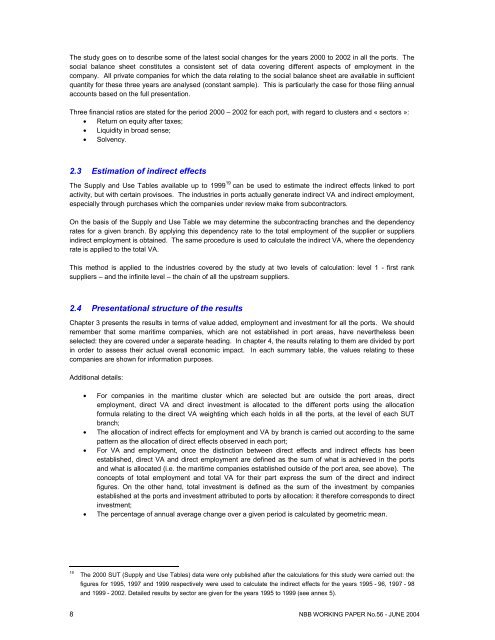Economic importance of the Flemish maritime ports: Report 2002
Economic importance of the Flemish maritime ports: Report 2002
Economic importance of the Flemish maritime ports: Report 2002
Create successful ePaper yourself
Turn your PDF publications into a flip-book with our unique Google optimized e-Paper software.
The study goes on to describe some <strong>of</strong> <strong>the</strong> latest social changes for <strong>the</strong> years 2000 to <strong>2002</strong> in all <strong>the</strong> <strong>ports</strong>. Thesocial balance sheet constitutes a consistent set <strong>of</strong> data covering different aspects <strong>of</strong> employment in <strong>the</strong>company. All private companies for which <strong>the</strong> data relating to <strong>the</strong> social balance sheet are available in sufficientquantity for <strong>the</strong>se three years are analysed (constant sample). This is particularly <strong>the</strong> case for those filing annualaccounts based on <strong>the</strong> full presentation.Three financial ratios are stated for <strong>the</strong> period 2000 – <strong>2002</strong> for each port, with regard to clusters and « sectors »:• Return on equity after taxes;• Liquidity in broad sense;• Solvency.2.3 Estimation <strong>of</strong> indirect effectsThe Supply and Use Tables available up to 1999 19 can be used to estimate <strong>the</strong> indirect effects linked to portactivity, but with certain provisoes. The industries in <strong>ports</strong> actually generate indirect VA and indirect employment,especially through purchases which <strong>the</strong> companies under review make from subcontractors.On <strong>the</strong> basis <strong>of</strong> <strong>the</strong> Supply and Use Table we may determine <strong>the</strong> subcontracting branches and <strong>the</strong> dependencyrates for a given branch. By applying this dependency rate to <strong>the</strong> total employment <strong>of</strong> <strong>the</strong> supplier or suppliersindirect employment is obtained. The same procedure is used to calculate <strong>the</strong> indirect VA, where <strong>the</strong> dependencyrate is applied to <strong>the</strong> total VA.This method is applied to <strong>the</strong> industries covered by <strong>the</strong> study at two levels <strong>of</strong> calculation: level 1 - first ranksuppliers – and <strong>the</strong> infinite level – <strong>the</strong> chain <strong>of</strong> all <strong>the</strong> upstream suppliers.2.4 Presentational structure <strong>of</strong> <strong>the</strong> resultsChapter 3 presents <strong>the</strong> results in terms <strong>of</strong> value added, employment and investment for all <strong>the</strong> <strong>ports</strong>. We shouldremember that some <strong>maritime</strong> companies, which are not established in port areas, have never<strong>the</strong>less beenselected: <strong>the</strong>y are covered under a separate heading. In chapter 4, <strong>the</strong> results relating to <strong>the</strong>m are divided by portin order to assess <strong>the</strong>ir actual overall economic impact. In each summary table, <strong>the</strong> values relating to <strong>the</strong>secompanies are shown for information purposes.Additional details:• For companies in <strong>the</strong> <strong>maritime</strong> cluster which are selected but are outside <strong>the</strong> port areas, directemployment, direct VA and direct investment is allocated to <strong>the</strong> different <strong>ports</strong> using <strong>the</strong> allocationformula relating to <strong>the</strong> direct VA weighting which each holds in all <strong>the</strong> <strong>ports</strong>, at <strong>the</strong> level <strong>of</strong> each SUTbranch;• The allocation <strong>of</strong> indirect effects for employment and VA by branch is carried out according to <strong>the</strong> samepattern as <strong>the</strong> allocation <strong>of</strong> direct effects observed in each port;• For VA and employment, once <strong>the</strong> distinction between direct effects and indirect effects has beenestablished, direct VA and direct employment are defined as <strong>the</strong> sum <strong>of</strong> what is achieved in <strong>the</strong> <strong>ports</strong>and what is allocated (i.e. <strong>the</strong> <strong>maritime</strong> companies established outside <strong>of</strong> <strong>the</strong> port area, see above). Theconcepts <strong>of</strong> total employment and total VA for <strong>the</strong>ir part express <strong>the</strong> sum <strong>of</strong> <strong>the</strong> direct and indirectfigures. On <strong>the</strong> o<strong>the</strong>r hand, total investment is defined as <strong>the</strong> sum <strong>of</strong> <strong>the</strong> investment by companiesestablished at <strong>the</strong> <strong>ports</strong> and investment attributed to <strong>ports</strong> by allocation: it <strong>the</strong>refore corresponds to directinvestment;• The percentage <strong>of</strong> annual average change over a given period is calculated by geometric mean.19The 2000 SUT (Supply and Use Tables) data were only published after <strong>the</strong> calculations for this study were carried out: <strong>the</strong>figures for 1995, 1997 and 1999 respectively were used to calculate <strong>the</strong> indirect effects for <strong>the</strong> years 1995 - 96, 1997 - 98and 1999 - <strong>2002</strong>. Detailed results by sector are given for <strong>the</strong> years 1995 to 1999 (see annex 5).8 NBB WORKING PAPER No.56 - JUNE 2004
















